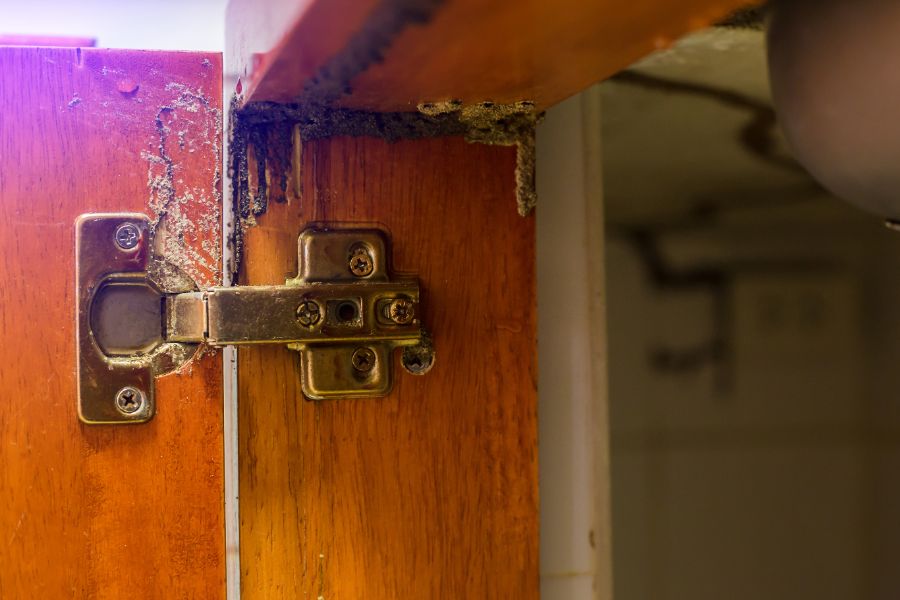
Termites are notorious for their ability to wreak havoc on wooden structures. If left unchecked, termite damage can lead to costly repairs and structural issues. If you want to protect your home or business, you need to be able to identify the signs of termite damage early on to mitigate these risks.
How Much Damage Can Termites Cause?
Termites are responsible for significant damage across the United States, costing homeowners billions of dollars annually. The extent of damage can vary depending on factors such as the size of the termite colony, the type of termite species involved, and the duration of the infestation.
A mature colony of termites, left undetected and untreated, can consume large amounts of wood and other cellulose materials in a relatively short period. This can lead to structural weakening of homes, requiring costly repairs and restoration efforts.
How Quickly Do Termites Cause Damage?
A mature termite colony with thousands of individuals can consume large amounts of wood and cellulose materials daily. In ideal conditions, termites can cause noticeable damage within a few months. That said, it can take months or years for a colony to grow large enough to cause such rapid destruction.
What Does Termite Damage Look Like?
Termites tunnel through wood to feed on cellulose. While they rarely leave their colonies, they do leave behind some telltale signs of their presence—including damage. Some examples of termite damage include:
- Hollowed-Out Wood: Termites tunnel through wood, consuming cellulose and leaving it hollowed-out or completely tunneled through. This can weaken structural integrity and cause wood to sound hollow when tapped. In severe cases, the wood may collapse under pressure.
- Wood Shavings: Piles of wood shavings, similar to sawdust, may accumulate near infested areas. These shavings are typically expelled from termite tunnels and can be found below kick-out holes or in corners where termites have been active.
- Warped or Bent Wood: Long-term termite infestations can cause wood structures to warp or bend, resembling water damage. This distortion occurs as termites hollow out wood from the inside, compromising its strength and shape.
- Cracked or Bubbled Surfaces: Internal walls, ceiling beams, or rafters may develop cracks due to termite activity within wooden structures. Floors may show signs of bubbling or sagging, especially if termites have compromised the sub-flooring or joists.
- Discolored Drywall or Paint: Moisture buildup from termite activity can cause paint to bubble, peel, or become discolored. Similarly, drywall may show signs of water damage, which is often mistaken for the actual cause of the problem.
Do You Have a Termite Problem? We Can Help.
Click the button below to leave your information & we'll be in touch in an hour or less.
Where Does Termite Damage Occur?
In addition to knowing what termite damage looks like, you should also know where to find it. Damage can take months or years to become apparent, so be sure to check these areas routinely for signs of termites:
- Walls and ceilings
- Foam insulation
- Floorboards
- Window frames
- Doors
- Home foundations
How to Prevent Termite Damage
Repairing termite damage can be expensive and disruptive, involving extensive renovations and sometimes even replacement of damaged structures. If you want to avoid the stress and expense of fixing termite damage, try following these steps to prevent infestations from forming:
- Eliminate Wood-to-Ground Contact: Termites thrive in soil, so minimize their access to food sources by ensuring that wooden structures such as decks, porches, and fences do not directly contact the ground. Consider using concrete or metal supports instead.
- Maintain Proper Ventilation: Ensure that attics, basements, and crawl spaces are properly ventilated to reduce humidity, as termites are attracted to moisture. Use dehumidifiers if necessary to keep humidity levels low.
- Seal Cracks and Openings: Seal any cracks or openings in your home’s foundation, walls, and roof to prevent termites from entering. Pay special attention to areas where utilities enter the structure.
- Remove Wood and Debris Near Your Home: Keep firewood, lumber, or any other wood debris away from your home. Store them at least 20 feet away from the house and elevate them off the ground.
- Schedule Regular Termite Inspections: Have your home inspected for termites annually by a professional pest control service. Early detection can prevent termite colonies from becoming established and causing significant damage.
Whether you’re looking to schedule a preventative treatment or suspect you have termites, Bug Out is here to help. Our professional technicians specialize in identifying and treating termite infestations using advanced techniques that yield long-term results. Contact us today to schedule an inspection and ensure your home remains termite-free.
Back to Termite Damage